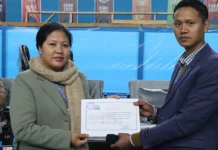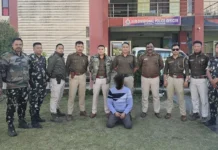[ Dama Miji Zongluju ]
The Akas, who also call themselves the ‘Hrusso’, have played an important role in Arunachal’s ancient and medieval history. The ancient history of the Akas of West Kameng district is depicted in their relations with an ancient king of Sonitpur (present Tezpur, Assam); who established themselves as one of the most powerful people during the Ahom and British period.
Dususow Pario had two sons, namely Tagi and Siggi. Nothing much is known about the younger son Siggi. However, Tagi grew up with a strong personality and became a successful chief of the Akas. With his power and influence, the Ahom government recognized him as an independent chief of the hills and referred to him as Tagi Raja.
Tagi hailed from a village called ‘Gohaithan’ in West Kameng district of Arunachal Pradesh. In British accounts, the Akas of present Husigaon, Buragaon, Gohaithan and Bhalukpong villages were known as Kapaschor Aka, but the people of these villages called themselves ‘Kuvatson’ or ‘Sanii- Giibii’.
The Kuvatson Akas claim that Tagi Raja drew his lineage from Bana, king of ancient Sonitpur, and after the death of Bhaluka Raja of Bhalukpong (10th -12th century or grandsons of Bana Raja), the Kuvatson Akas gradually settled towards the hills. So, the Akas frequently visited plains to exchange their agricultural products with the plains people and they shared agricultural fields for six months in the foothills or their boundary areas. They collected their share as revenue or tax from those who engaged in their agricultural lands of the foothills. This system of practice was termed as ‘Khajiina’ in the Aka dialect.
This system continued even after the Ahom established its supremacy over Assam in 1228 AD. However, the Ahom Prince Pratap Singha changed this practice slightly in 1603-41 AD, and introduced the ‘posa system’. Accordingly, the Ahom government officially granted posa to the Akas in the Charduar areas of the plains.
The Ahom-Aka relations gradually deteriorated after the annexation of Assam by the British in 1826 AD. The British started to interfere in their symbiotic relations and gradually encroached over the lands and forests of the Aka territory and imposed new taxation.
The Akas who lived independently in nature did not like the British supremacy, which resulted in the Akas, under their chief, Tagi Raja, raiding the British territory and murdering the native official-in-charge of Charduar with 20 of his immediate followers in 1828.
According to an Aka narrator, when Tagi came down to the plains to collect Khajiina or dues (posa), he was treacherously captured at Balipara after a three-day stern chase by the British forces and sent to jail in Guwahati (1829). While at the jail in Guwahati, the British authority learnt of Tagi Raja’s personality and character, and instead of imprisoning him, he was given a job in the British Office at Guwahati as punishment.
There he married for the second time – an Assamese girl -and had two female children. After repeated appeals from his family and the entire Aka people, he was released from Guwahati (1832). Once freed, he went back to the hills and rallying his followers behind, raided and murdered all those who were connected with his capture.
On 3rd February, 1835, he burnt the British infantry outpost at Balipara, massacring 17 souls. In December 1837, he carried off several captives. He led repeated raids into the plains of British territory in 1837- 39 and 1841.
Following this, the British government stopped the payment of posa of the Akas, closed the Duars to trade. As a result, Tagi Raja and other chiefs submitted to the British authority by 1860 through the kotokis (official interpreters). Finally, an agreement was made, where Tagi Raja agreed not to attack the British territory anymore in consideration of a monthly political pension of Rs 20 and other chiefs of the Akas accepted stipends amounting to Rs 360 per annum. The southern boundary of the Aka territory was demarcated in 1872-73 and they (Akas) were granted 49 acres of land in the plains to gratify them.
Tagi Raja was said to be a terror for the British government and neighbouring tribes. He was also one of those revolutionists from Arunachal Pradesh that always tried to resist the British expedition into their territory. He passed away in 1873.
Medhi was the eldest son and successor of Tagi Raja. He was a great warrior, general and revolutionary leader of Arunachal Pradesh, who was a bitter enemy of the British and did not like British supremacy.
Medhi refused to recognize the boundary line which was demarcated in 1872-73. According to him, this demarcation was made forcefully. However, a settlement was made through a mediator named Lakhidhar, a revenue official of Balipara.
In 1873, Medhi came down to Tezpur and was sanctioned the grant of 82 puras of land by the British government. Though a settlement was put into effect, the Aka chief under Medhi Raja remained discontent since the promulgation of the Bengal Eastern Frontier Regulation Act 1873 (also known as Inner Line Permit). It was believed that this Regulation Act deprived the Akas their customary rights – of catching wild animals, tapping rubber trees and collecting edible items in the forests at the foothills. They were also denied using the paths to the plains by officials.
In January 1882, the forest guard reported that a large body of the Akas and Nyishis had come down and set up boundary marks in the foothills at Potashali, Diju and Naminimukh, declaring that they would not allow anyone to cross over those marked points.
In October 1883, a British official named Lakhidhar was deputed to the Aka Hills to collect some specimens of agricultural and other implements and also to persuade an Aka ‘raja’ and a ‘rani’ to come down with their ornaments for being modelled at an exhibition to be held at Calcutta. Since the Akas were naturally furious, already suspicious, discontented and resented the British supremacy, they seized Lakhidhar and kept him in captivity.
On 10 November, 1883, Medhi sent a party under his younger brother Sondi to Balipara for an attack as a lesson to the British government for humiliating the Aka society by sending for an Aka ‘raja’ and ‘rani’ at an exhibition. A group of Akas numbering about one hundred, under the command of Sondi Dususow, attacked Balipara and abducted the forest ranger and the forest clerk on duty.
This led to the famous Anglo-Aka War of 1883-84.
On 17 December, 1883 a punitive expedition was sent against the Akas under the command of Major Beresford. The troops of Beresford could not cross over the deep valley of Tenga River (locally known as Hudiigii) at an altitude of 2500 feet because of the guerrilla warfare, where the Akas showered poisonous arrows and compelled Major Beresford and his troops to make a hasty retreat.
As per the Aka narrator, the Akas valiantly fought against the British at the deep valley of Tenga river near Gohaithan village and males of all Aka villages were involved in this war. The Mijis also supported the Akas as the war weapons, like poisonous bows and arrows were supplied by the Mijis. Further, the narrator says that a large number of British forces were wounded and killed but no major casualty was reported on the Aka side, except one man named Khabisow Labu, who received a minor injury on his ankle by a British gun.
The arrival of reinforcement under Brigadier General Hill with mountain guns altered the situation. On 8 January, 1884 the war between the Akas and the British forces was renewed. As per Aka sources, the warriors were scattered while searching and gathering more war equipment and food. In the meantime, more British forces arrived at Medhi’s village and started gunfire. While not a single Aka warrior was found, the village with their granaries was burnt and cattle were lifted.
However, Medhi did not surrender, and then Captain Maxwell started negotiation with the scattered parties of the Akas. While the Akas did not wish to negotiate, the economic blockade of the Aka Hills finally led Medhi and his brother Sondi to surrender in 1888 and enter into a peace settlement.
This resulted in the release of the two forest officials, while Lakhidar was reported dead.
Economic blockades were lifted, their posa system was restored from 1890 and the practice of the payment of posa is still extant.
The state government should consider recognizing both Tagi Raja and Medhi Raja as unsung heroes of the Aka community and officially declare them as freedom fighters from Arunachal Pradesh.
They should be remembered alongside Matmur Jamoh and other freedom fighters of North East India during this ongoing programme of Aazadi Ka Amrut Mahotsav. (The contributor is a teacher at Government Middle School, Lepang Huda, Bhalukpong, West Kameng district)



